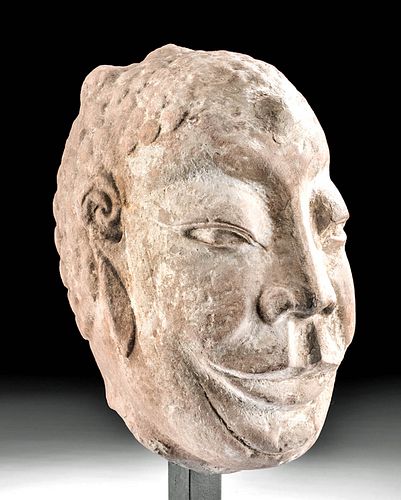Chinese Wei Dynasty Stone Head - Dipankara Buddha
Lot 90
About Seller
Artemis Fine Arts
686 S Taylor Ave, Ste 106
Louisville, CO 80027
United States
Selling antiquities, ancient and ethnographic art online since 1993, Artemis Gallery specializes in Classical Antiquities (Egyptian, Greek, Roman, Near Eastern), Asian, Pre-Columbian, African / Tribal / Oceanographic art. Our extensive inventory includes pottery, stone, metal, wood, glass and textil...Read more
Categories
Estimate:
$5,000 - $7,500
Absentee vs Live bid
Two ways to bid:
- Leave a max absentee bid and the platform will bid on your behalf up to your maximum bid during the live auction.
- Bid live during the auction and your bids will be submitted real-time to the auctioneer.
Bid Increments
| Price | Bid Increment |
|---|---|
| $0 | $25 |
| $300 | $50 |
| $1,000 | $100 |
| $2,000 | $250 |
| $5,000 | $500 |
| $10,000 | $1,000 |
| $20,000 | $2,500 |
| $50,000 | $5,000 |
| $100,000 | $10,000 |
| $200,000 | $20,000 |
About Auction
By Artemis Fine Arts
Oct 8, 2020
Set Reminder
2020-10-08 10:00:00
2020-10-08 10:00:00
America/New_York
Bidsquare
Bidsquare : Exceptional Antiquities, Asian, Ethnographic
https://www.bidsquare.com/auctions/artemis-gallery/exceptional-antiquities-asian-ethnographic-5796
Museum-worthy examples of Egyptian, Greek, Roman, Etruscan, Near Eastern, Far East / Asian, Pre-Columbian, African / Tribal,Oceanic, Native American, Spanish Colonial, Russian, Fossils, Ancient Jewelry, Fine Art, so much more! Artemis Fine Arts info@artemisgallery.com
Museum-worthy examples of Egyptian, Greek, Roman, Etruscan, Near Eastern, Far East / Asian, Pre-Columbian, African / Tribal,Oceanic, Native American, Spanish Colonial, Russian, Fossils, Ancient Jewelry, Fine Art, so much more! Artemis Fine Arts info@artemisgallery.com
- Lot Description
East Asia, China, Northern Wei Dynasty, ca. 386 to 535 CE. A graceful sandstone carving of the Dipankara Buddha, featuring exaggeratedly large facial features on a slender face: huge, almond-shaped eyes underneath a shallow but defined brow with thick eyebrows; an elegant, thin nose that broadens at the nostrils, and a large-lipped mouth curved upward into a wide smile. Small ears and a head of tightly curled hair complete the head. The Dipankara Buddha is one of the "Buddhas of the past", with his name literally meaning "Lamp Bearer". This head would have been attached to a larger sculpture, and the figure would have been displayed with others - probably bodhisattvas, as this Buddha is rarely portrayed alone. It would have stood in a cave or temple. The remains of white pigment are visible on the face. Size: 8.5" W x 9.75" H (21.6 cm x 24.8 cm); 13.85" H (35.2 cm) on included custom stand.
The Wei Dynasty represents the beginning of Buddhist influence on Chinese art. This sculpture was made in a region of China that had a great deal of contact with the outside world and was ruled by foreign monarchs. Buddhist figures are portrayed as graceful and thin, draped in the robes of scholars. This elegant carving exemplifies that style.
Provenance: ex-private Micklautz collection, Hawaii, USA, collected from 1940 to 1998
All items legal to buy/sell under U.S. Statute covering cultural patrimony Code 2600, CHAPTER 14, and are guaranteed to be as described or your money back.
A Certificate of Authenticity will accompany all winning bids.
We ship worldwide and handle all shipping in-house for your convenience.
#151852Repaired on the nose and forehead - these areas of repair are small, well done, and unobtrusive. Otherwise in great condition with some weathering to the stone. Some original pigment remaining and nice deposits on surface. This head would have once been part of a larger sculpture.Condition
- Shipping Info
-
All shipping is handled in-house for your convenience. Your invoice from Artemis Gallery will include shipping calculation instructions. If in doubt, please inquire BEFORE bidding for estimated shipping costs for individual items.
-
- Buyer's Premium



 EUR
EUR CAD
CAD AUD
AUD GBP
GBP MXN
MXN HKD
HKD CNY
CNY MYR
MYR SEK
SEK SGD
SGD CHF
CHF THB
THB














